Renee Wilkinson's Blog, page 33
May 20, 2011
What to Eat
It's that time in the term. I am sleeping just enough… I am showering just enough… I am battling colds just enough… and I have a lot of drawing to do. That's about all I can handle.
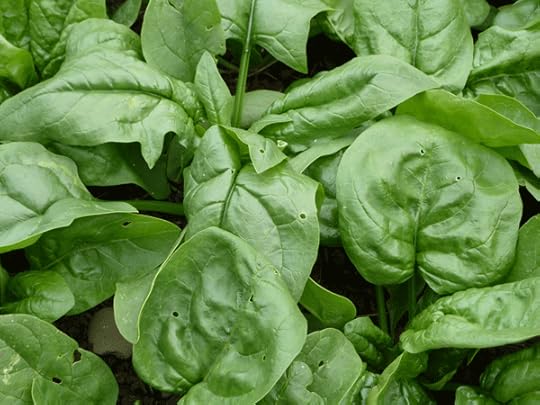 But to temper that, I am eating more than well enough. I cannot compromise on that point. I was explaining to a friend just earlier this evening how that works. When you live close to the land, it's no longer an option to separate from it. I have to plant seeds in spring. I have to eat the last of the winter greens. I have to pick lilacs to fill the house.
But to temper that, I am eating more than well enough. I cannot compromise on that point. I was explaining to a friend just earlier this evening how that works. When you live close to the land, it's no longer an option to separate from it. I have to plant seeds in spring. I have to eat the last of the winter greens. I have to pick lilacs to fill the house.
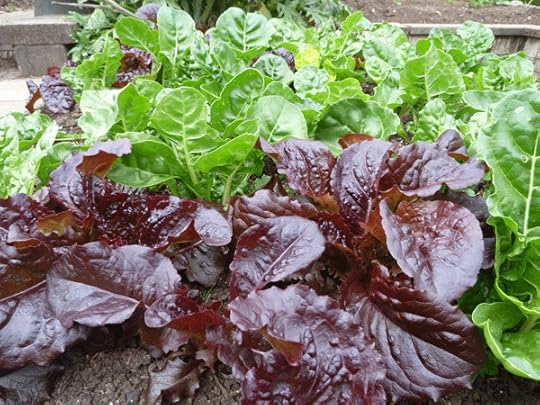 Despite grad school woes, I am still harvesting early spring crops from the Urban Farm. I have been cooking up swiss chard with leftover bacon grease and hot chili flakes. I pack sandwiches with layers of spinach to give me the iron I need to power through these last couple weeks.
Despite grad school woes, I am still harvesting early spring crops from the Urban Farm. I have been cooking up swiss chard with leftover bacon grease and hot chili flakes. I pack sandwiches with layers of spinach to give me the iron I need to power through these last couple weeks.
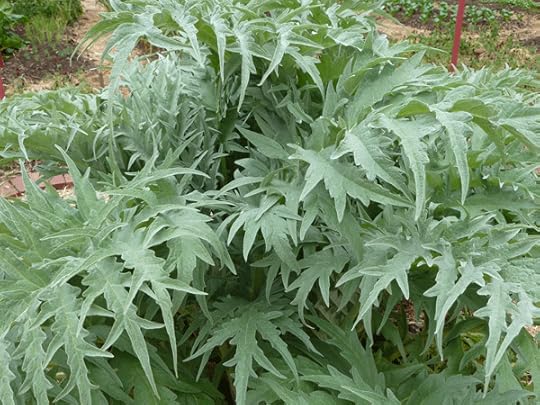 And for a moment between harvesting, I stop to admire the artichokes. One of the few perennial vegetable crops we can grow here in the Pacific Northwest. They look robust, healthy and give me promise that my favorite vegetable will be in abundance this year. It was a fairly mild winter and that means a season of plenty. I can't wait til summer…
And for a moment between harvesting, I stop to admire the artichokes. One of the few perennial vegetable crops we can grow here in the Pacific Northwest. They look robust, healthy and give me promise that my favorite vegetable will be in abundance this year. It was a fairly mild winter and that means a season of plenty. I can't wait til summer…
May 14, 2011
Spring Vegetable Starts
Last weekend, my nephews went with me on a tour of garden and feed stores. Their family is interested in keeping backyard chickens after babysitting ours last summer while we were living in New York. I was also getting impatient with the slow seed germination in our garden and decided to buy a few starts to take the edge off this waiting game.
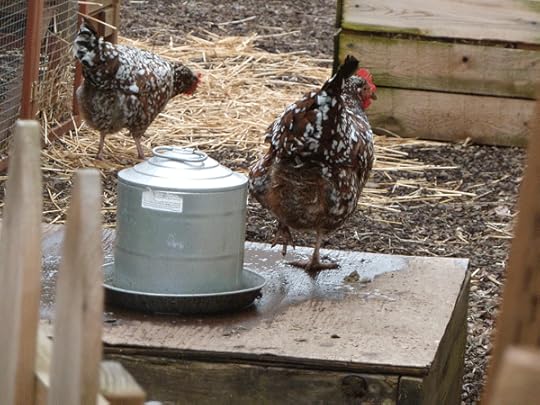 We stopped by a couple local feed stores and admired the chick varieties still available for sale. It's not too late to raise chicks for those still interested this season! I fell head over heels for these lovely Wyandotte hens that live in demonstration coops at the Eugene Backyard Farmer.
We stopped by a couple local feed stores and admired the chick varieties still available for sale. It's not too late to raise chicks for those still interested this season! I fell head over heels for these lovely Wyandotte hens that live in demonstration coops at the Eugene Backyard Farmer.
We picked up some local vegetable starts later in the day. Jay kept the nephews occupied while I did my usual investigation into the best possible plants. Here is my checklist of what to avoid when selecting plant starts:
Mold on the soil – This is a sign they have been over-watered, which is not healthy for the plants and also encourages disease.
Dried out soil – Alternatively, bone dry soil means the plants may be stressed by lack of water during this tender time.
Root bound – I gently check the tray to ensure the roots of the plant have not encircled the container too tightly. It is hard to get them untangled without damage and leaving them wound so tightly means they will be less likely to grow out, deep into the soil.
Yellow or dead leaves – Only pick the healthiest, most vigorous starts that will give you the best chance of a successful garden.
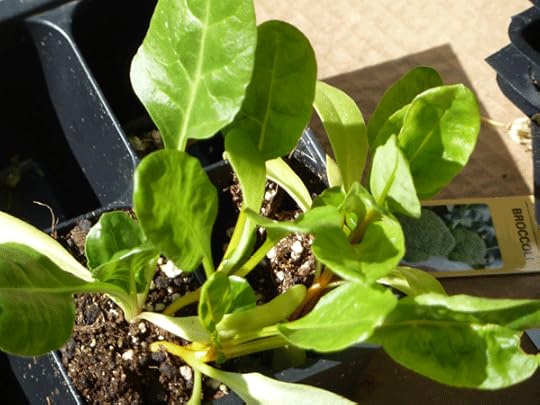 The weather here is just getting warm and sunny enough for the seeds I planted a couple weeks ago to pop their heads up. I'm still hopeful more carrot and beet seedlings show up. But I filled in other patches with lettuces, swiss chard, broccoli, kale and spinach. Our garden patch is starting to look great. Only a couple more weeks of finishing off the winter preserves and we should be able to harvest from our backyard.
The weather here is just getting warm and sunny enough for the seeds I planted a couple weeks ago to pop their heads up. I'm still hopeful more carrot and beet seedlings show up. But I filled in other patches with lettuces, swiss chard, broccoli, kale and spinach. Our garden patch is starting to look great. Only a couple more weeks of finishing off the winter preserves and we should be able to harvest from our backyard.
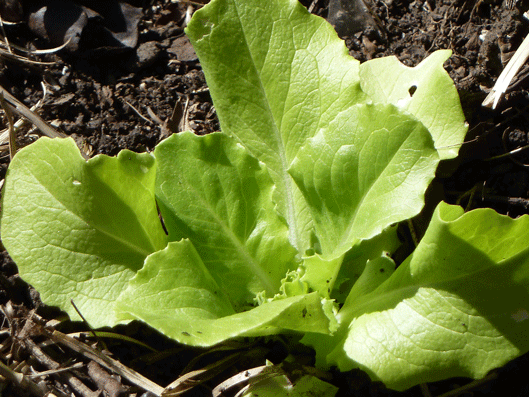 In other news, if you live in the Eugene area, come visit me this evening! I will be at Barnes & Noble at 7:00pm talking about my homesteading journey and signing books. It would be great to meet more of the Eugene homesteading community.
In other news, if you live in the Eugene area, come visit me this evening! I will be at Barnes & Noble at 7:00pm talking about my homesteading journey and signing books. It would be great to meet more of the Eugene homesteading community.
May 10, 2011
Heiße Zitrone
I got hit with either a bad, bad cold or the flu and have been held up on the couch for the last two days. I have a fever and every bone in my body aches. Admittedly, I am not the best patient because I have a hard time sitting still.
That said, I am trying to give in to resting. I've been drinking ginger beer and eating some thick lentil soup. I have also whipped up what I call Erika's Elixir, or Heiße Zitrone.
 My friend Erika is German-American and her mother used to make this for her whenever she got sick. I included the recipe in my book because it's a great way to use up honey from your bees or lemon from your citrus trees. It gives your body a shot of vitamin C and soothes achy bones.
My friend Erika is German-American and her mother used to make this for her whenever she got sick. I included the recipe in my book because it's a great way to use up honey from your bees or lemon from your citrus trees. It gives your body a shot of vitamin C and soothes achy bones.
Heiße Zitrone (spelled in English as heissezitrone)
Heat four cups of water on the stove with 1/4 cup of honey and 1/4 tsp grated ginger (optional)
Once boiling, stir in the juice of two ripe lemons
Drink as-is or add a little whiskey to help you sleep
Despite being under the weather, I have a Twitter party planned for tonight with the folks at Holistic Moms Network starting around 7 PST. If you use Twitter, shoot me a homesteading question or perhaps share with me your go-to cold recipes. Just put @hipchickdigs in your tweet and the hashtag #holisticmoms at the end.
Heiße Zitrone
May 4, 2011
Chartreuse and Purple Garden
Everyone has their favorite color combination and mine is blooming around town this spring: chartreuse and purple. For me, chartreuse is a beautiful hint of spring – something new, young and vibrant. Purples feel soothing to me, calming and tranquil. When it comes to my backyard haven, I would love to lounge around in a place that feels fresh and calm.
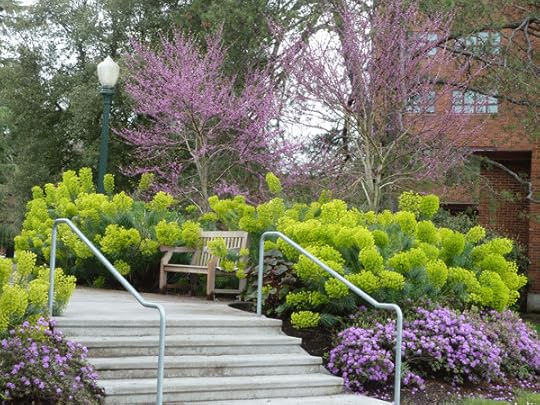 It's funny that I have come around to this palette. I had a roommate as an undergrad who threw this color all over our room. Her bed spread, backpack, wall hangings, lamp, even her pens and pencils were a bright lavender and lime combo. So I'm not advocating I paint my life in these colors. But for an outdoor "room", it just draws me toward it.
It's funny that I have come around to this palette. I had a roommate as an undergrad who threw this color all over our room. Her bed spread, backpack, wall hangings, lamp, even her pens and pencils were a bright lavender and lime combo. So I'm not advocating I paint my life in these colors. But for an outdoor "room", it just draws me toward it.
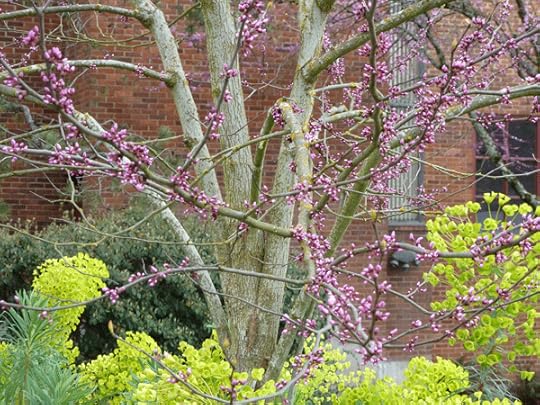 The flowering trees in these pictures are of Cercis canadensis (common name: Eastern Redbud). This is a beautiful tree that blooms in the spring and has lovely yellow fall color. You might search around to see if there is a native version in your part of the country. The flowers are edible and, although they don't taste very distinct, they would be really pretty on a delicate spring salad. Ooooh, or maybe sprinkled on cupcakes? Wow, I'm getting carried away…
The flowering trees in these pictures are of Cercis canadensis (common name: Eastern Redbud). This is a beautiful tree that blooms in the spring and has lovely yellow fall color. You might search around to see if there is a native version in your part of the country. The flowers are edible and, although they don't taste very distinct, they would be really pretty on a delicate spring salad. Ooooh, or maybe sprinkled on cupcakes? Wow, I'm getting carried away…
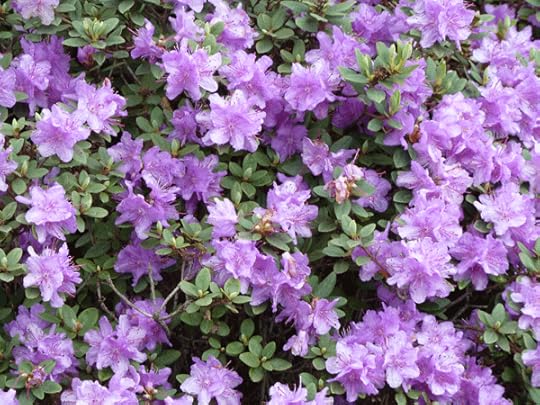 The evergreen backbone of this little garden arrangement is the purple-blooming variety of Azalea. It is an evergreen, so there is nice structure here in the winter months. There are hundreds, if not thousands, of cultivars of azalea. This one will probably bloom from about April-May.
The evergreen backbone of this little garden arrangement is the purple-blooming variety of Azalea. It is an evergreen, so there is nice structure here in the winter months. There are hundreds, if not thousands, of cultivars of azalea. This one will probably bloom from about April-May.
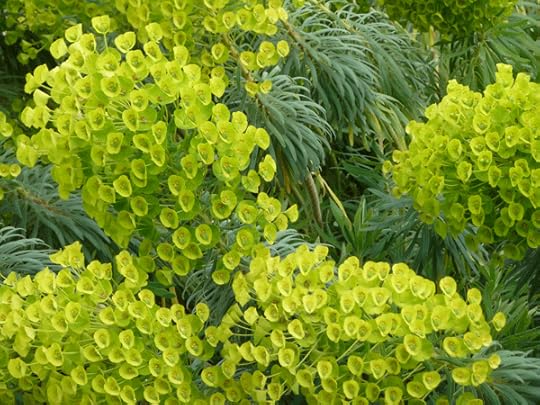 Euphorbia is the chartreuse, outer-space looking plant. It is not considered invasive (yet), but it can take over an area if you don't keep an eye on it. There are lots of cultivars of Euphorbia that range from dark olive greens to peachy colors.
Euphorbia is the chartreuse, outer-space looking plant. It is not considered invasive (yet), but it can take over an area if you don't keep an eye on it. There are lots of cultivars of Euphorbia that range from dark olive greens to peachy colors.
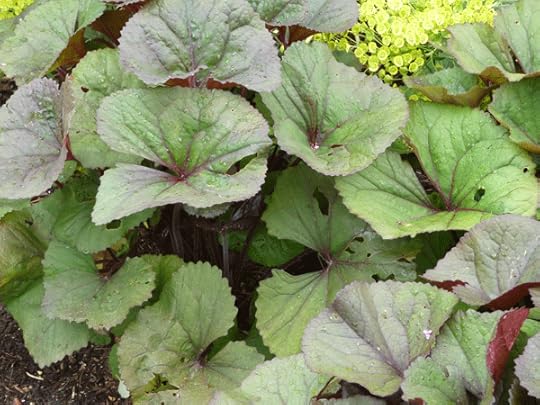 And finally, there is this dark, low-to-the-ground herbaceous plant. It adds a nice ground layer to the planting. The texture is a nice balance to the fern-like Euphorbia and the rounded Azalea. And that dark purple makes the bright colors pop.
And finally, there is this dark, low-to-the-ground herbaceous plant. It adds a nice ground layer to the planting. The texture is a nice balance to the fern-like Euphorbia and the rounded Azalea. And that dark purple makes the bright colors pop.
I think this arrangement works because it is a simple palette that was planted en masse. There is a good balance between an evergreen shrub layer, the beautiful bark of the Redbud, and the seasonal color. I wonder if you have a color palette you try to stick to, or is it a combination of whatever grabbed your eye at the nursery?
May 2, 2011
Impatient Spring
The seeds I planted a few weeks ago are sprouting all over the raised beds. Some seedlings have their first set of leaves, but the "true" leaves have yet to grow in. At this point, it is hard to tell the weeds from the intentional crops. Hopefully another few days of warm sun will get them going enough to tell me what to pull and what to fertilize.
 There are a few surprises in the garden beds. Exhibit A is the potato growing in the middle of the bed. It must have been buried in the compost pile and mistakenly spread into the raised beds. I'll transplant that to the actual potato bed I planted this weekend.
There are a few surprises in the garden beds. Exhibit A is the potato growing in the middle of the bed. It must have been buried in the compost pile and mistakenly spread into the raised beds. I'll transplant that to the actual potato bed I planted this weekend.
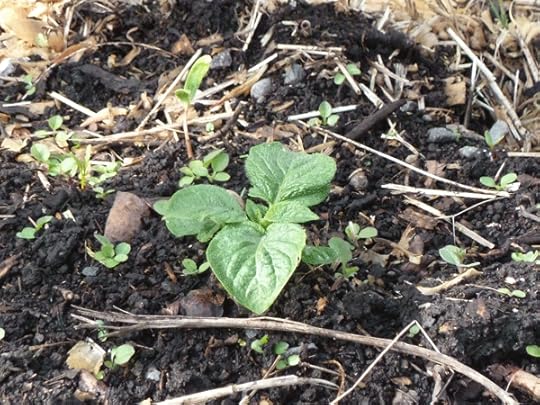 I'm feeling a little discouraged right now with the progress of our garden. I'm not sure if I should wait it out, cover them with plastic to warm them up, or just buy some starts to take the edge off the waiting game. It's May and I'm just ready already!
I'm feeling a little discouraged right now with the progress of our garden. I'm not sure if I should wait it out, cover them with plastic to warm them up, or just buy some starts to take the edge off the waiting game. It's May and I'm just ready already!
April 28, 2011
Building the Shared Run
Ducks need more outside room generally than chickens, so we set about building a large run for our new flock. We planned on about five square feet of outside space per duck, which meant we needed a run that was twenty square feet total. Since we are renting this year, nothing can be permanent about the duck house and run.
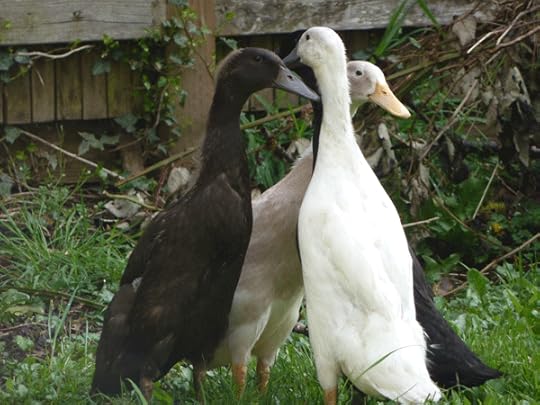 The chickens and ducks each have their own pecking order for their individual flocks. They will also need to sort out which birds are at the top as a combined flock. To lessen the pain of that transition, we constructed a large run that lets the flocks see each other without having access to each other just yet.
The chickens and ducks each have their own pecking order for their individual flocks. They will also need to sort out which birds are at the top as a combined flock. To lessen the pain of that transition, we constructed a large run that lets the flocks see each other without having access to each other just yet.
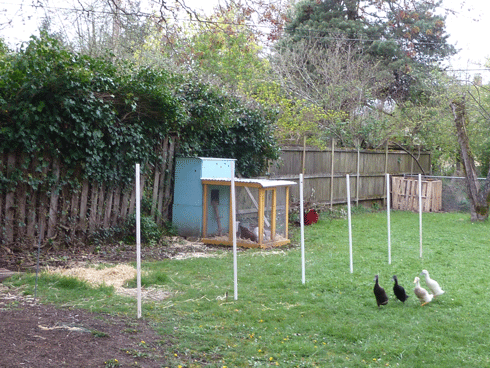 We built the large duck run around the enclosed chicken run. As they get used to each other, we have the option to open the chicken run and give everyone a chance to share the large run. In addition, we fenced off the raised beds which makes it easier to let everyone free-range in the backyard without destroying our crops.
We built the large duck run around the enclosed chicken run. As they get used to each other, we have the option to open the chicken run and give everyone a chance to share the large run. In addition, we fenced off the raised beds which makes it easier to let everyone free-range in the backyard without destroying our crops.
We used 4′ rebar every five feet, hammered down about one foot into the ground. Our local recycling store had cheap PVC pipes, which we put over the rebar like fence posts. We bought 5′ metal fencing that we then wrapped around the poles and secured with zipties. We used poultry staples to hammer the ends into our duck house and chicken coop.
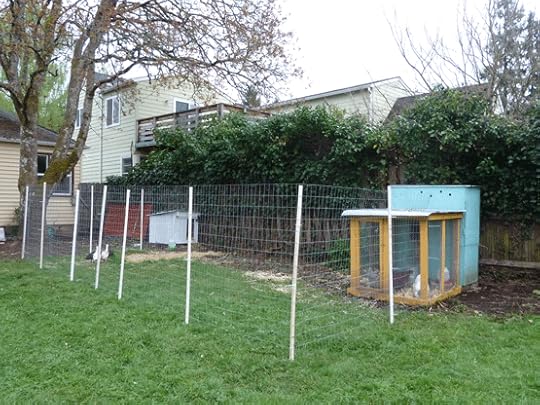 When we move eventually, the poles can be pulled out, the fencing wrapped up and the coops carried into the moving truck. One major drawback is that a determined predator could probably dig under the large run. We haven't seen signs of raccoons in our neighborhood and are hoping that doesn't become an issue.
When we move eventually, the poles can be pulled out, the fencing wrapped up and the coops carried into the moving truck. One major drawback is that a determined predator could probably dig under the large run. We haven't seen signs of raccoons in our neighborhood and are hoping that doesn't become an issue.
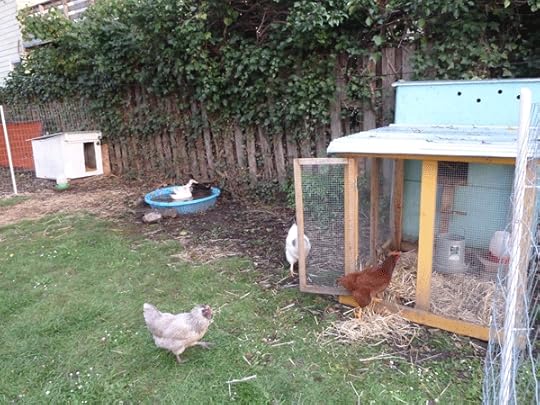 This has turned out to be a really nice solution to constructing a large, but portable, housing setup for ducks. The flocks seem to be curious about each other and everyone is playing nice so far. We moved in a kiddie pool for the ducks recently and they seem to have plenty of room to play.
This has turned out to be a really nice solution to constructing a large, but portable, housing setup for ducks. The flocks seem to be curious about each other and everyone is playing nice so far. We moved in a kiddie pool for the ducks recently and they seem to have plenty of room to play.
April 26, 2011
Building the Duck House
There are lots of ways to make a duck house and the one you build is based on any combination of the following factors:
safety from predators
carpentry skill level
time
money
portability
In our case, we are currently renting our homestead while I finished grad school. (So excited to get back to our permanent plot in Portland…) So what we build has to move with us. I also never seem to have enough time or money being in school right now.
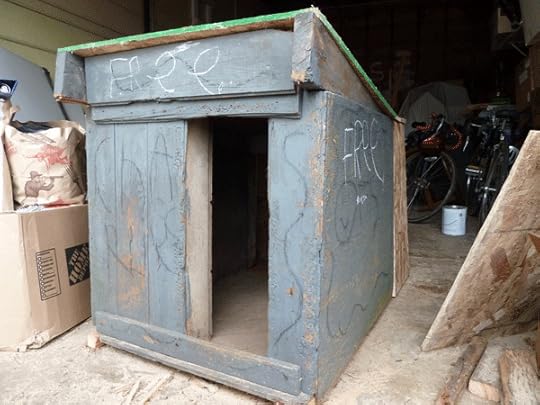 Jay found a doghouse on the free section of Craig's List and I have always wanted to reuse one for backyard livestock purposes. That was a great start to constructing the duck house portion. It wasn't quite big enough, so Jay added on a couple more feet using recycled materials.
Jay found a doghouse on the free section of Craig's List and I have always wanted to reuse one for backyard livestock purposes. That was a great start to constructing the duck house portion. It wasn't quite big enough, so Jay added on a couple more feet using recycled materials.
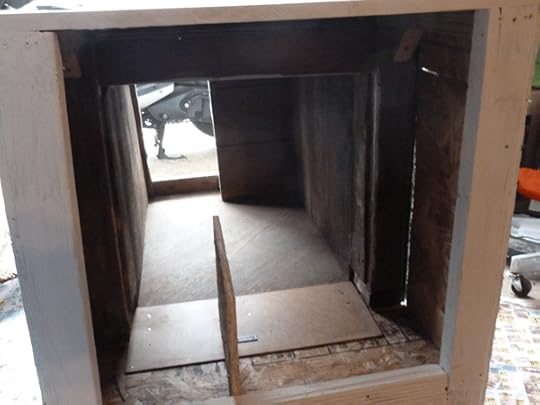 The inside is really simple. There is space to keep their duck feed and a nesting box for laying eggs. We still need to construct a door, in case we need to lock them up at night. But everything came together pretty quickly and pretty cheaply.
The inside is really simple. There is space to keep their duck feed and a nesting box for laying eggs. We still need to construct a door, in case we need to lock them up at night. But everything came together pretty quickly and pretty cheaply.
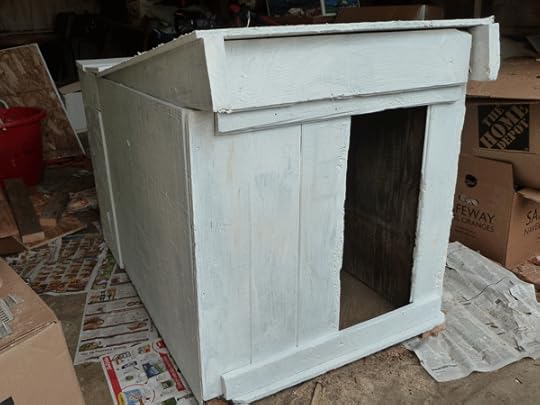 We hammered some corrugated metal onto the roof for a couple reasons: it matches the other coops in our backyard and will help direct rain off the duck house instead of through the cracks. It is now ready for a final paint job!
We hammered some corrugated metal onto the roof for a couple reasons: it matches the other coops in our backyard and will help direct rain off the duck house instead of through the cracks. It is now ready for a final paint job!
April 24, 2011
Duck Names
We finally settled on names for the newest additions to the backyard homestead. There were some really good suggestions from comments my earlier post, my Facebook page, plus a few Twitter messages. Several would have been good future kid names, so we reserved those  But here they are, the newly named ducks:
But here they are, the newly named ducks:
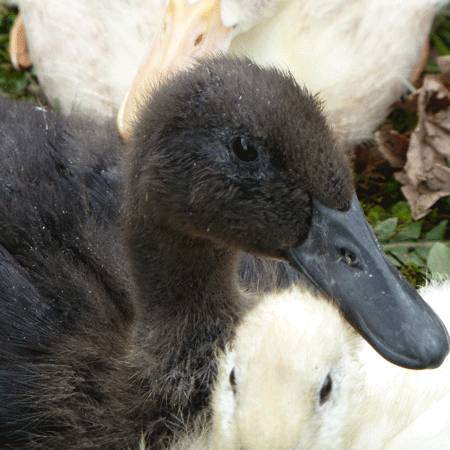 Pepper is our black runner duck and one of the first to be named. She seemed spunky and energetic right off the bat. Her fuzz in the picture above has been replaced with jet black feathers. We can catch hints of green in their shine when it's sunny outside. Beautiful!
Pepper is our black runner duck and one of the first to be named. She seemed spunky and energetic right off the bat. Her fuzz in the picture above has been replaced with jet black feathers. We can catch hints of green in their shine when it's sunny outside. Beautiful!
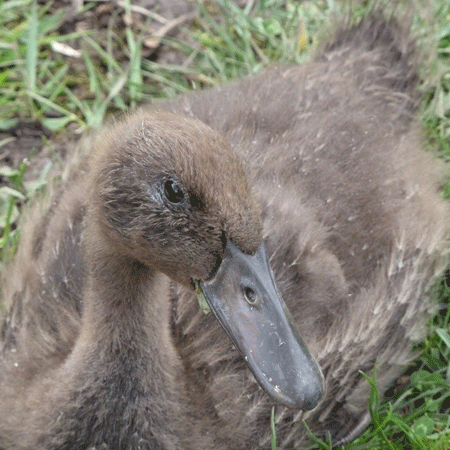 The next duck to get named was Mildred, or Millie for short. Millie seemed timid at first, but appears to be a contender for the top of the pecking order. Her coloring is described as chocolate and she appears to be the bravest when we hand feed them.
The next duck to get named was Mildred, or Millie for short. Millie seemed timid at first, but appears to be a contender for the top of the pecking order. Her coloring is described as chocolate and she appears to be the bravest when we hand feed them.
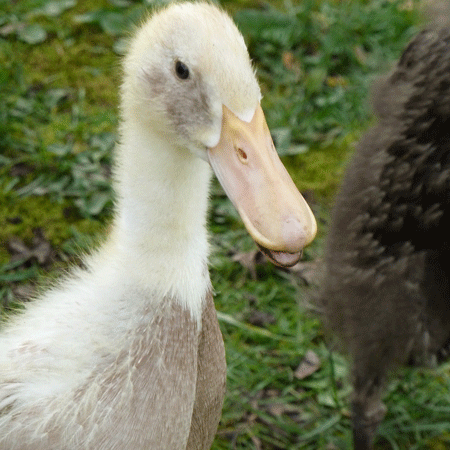 Bertie (Birdie) is the white and fawn colored duck who was named by my nephew Evan. She has the classic yellow beak and was always the bigger duckling from the start. She turned out to be pretty shy and usually hangs back in the flock to see what the other girls do. Her baby fuzz has been replaced with lots of beige feathers.
Bertie (Birdie) is the white and fawn colored duck who was named by my nephew Evan. She has the classic yellow beak and was always the bigger duckling from the start. She turned out to be pretty shy and usually hangs back in the flock to see what the other girls do. Her baby fuzz has been replaced with lots of beige feathers.
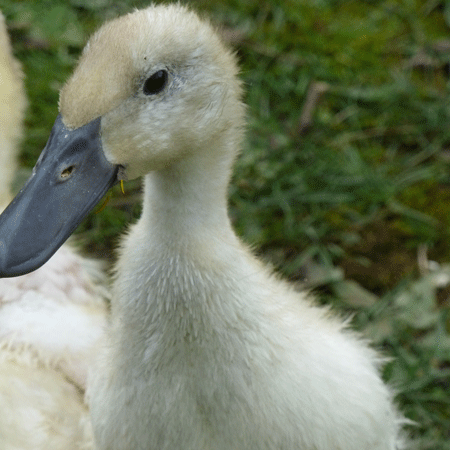 And finally, our favorite, Bess. She is the blue duck who has light gray feathers and a blue-tinted beak. We loved the classic name for such a classically elegant lady. Bess is the other contender for the top of the pecking order.
And finally, our favorite, Bess. She is the blue duck who has light gray feathers and a blue-tinted beak. We loved the classic name for such a classically elegant lady. Bess is the other contender for the top of the pecking order.
 The ducks have been so easy to raise and are now making the transition to living outside on their own. They are a tight-knit flock, always sticking together. Hopefully they will begin to relax more seeing us with them in the backyard. Despite our efforts, they seem to be a bit skittish still.
The ducks have been so easy to raise and are now making the transition to living outside on their own. They are a tight-knit flock, always sticking together. Hopefully they will begin to relax more seeing us with them in the backyard. Despite our efforts, they seem to be a bit skittish still.
April 20, 2011
I'm Somebody!
I am honored to have had my first book signing event at Powell's City of Books in Portland this past Sunday. When I arrived, I saw my name on their list of author events and my nervousness was replaced with excitement.My mind raced immediately to that scene from the movie The Jerk. Steve Martin's character gets the new phone book, sees his name and starts yelling "I'm Somebody!!! My name is in the phone book!!!" Well, Powell's, you had the same effect on me.
My book had been held up in customs as it made its way from the printer overseas to the bookstores in the US. So it actually wasn't until I got to Powell's that afternoon that I finally got to hold my finished book in my hands. My smile just got bigger and bigger as I flipped through it.
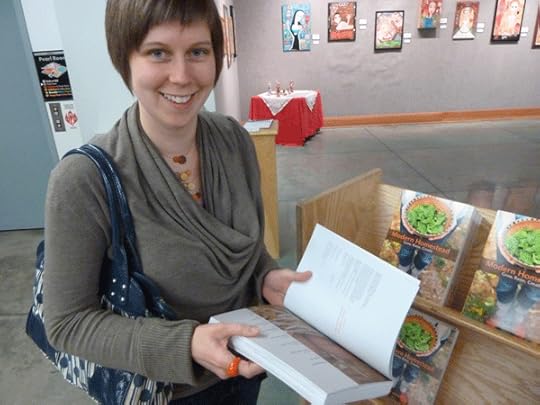 Over a year's worth of myself was poured into this book and it felt really heavy in my hands. I covered everything I could think to include in a book about homesteading: soil science, worm composting, seed starting, container gardening, building raised beds, sourcing cheap soil, fighting garden pests… and that's just the chapter on growing!
Over a year's worth of myself was poured into this book and it felt really heavy in my hands. I covered everything I could think to include in a book about homesteading: soil science, worm composting, seed starting, container gardening, building raised beds, sourcing cheap soil, fighting garden pests… and that's just the chapter on growing!
The chapter on preserving the harvest covers freezing, drying, canning, and learning to eat fresh. There are simple recipes for making your own green cleaners. And the backyard critters chapter covers chickens, ducks, goats, bees and native wildlife. I tried to include options for renters and home owners a like, so that book can grow with the reader's lifestyle.
Anyway, it feels like a total whirlwind and I am really excited to be on this fun ride. I started a page on Facebook for this blog and the book. I thought this might be an easy way to update people on future signings we have planned, show off pretty pictures that don't make it into blog posts, and share tips this growing season. I hope you "like" the page and can share this journey with me!
April 15, 2011
Poultry-Proof Garden
We love having our chickens free-range in our backyard. They eat a wider range of food, which saves us some money on chicken feed and also makes their eggs taste ten times better. But they can be really destructive in the garden beds – trampling seedlings in search for the next great worm.
It's even more important for backyard ducks to have some free-range access, in my humble opinion. They need a greater amount of space than chickens and it will be a nice, neutral environment for them mix in with the chicken flock. Because each group will have a pecking order established, I imagine there will be some sorting out of "who's the boss" when they move outside.
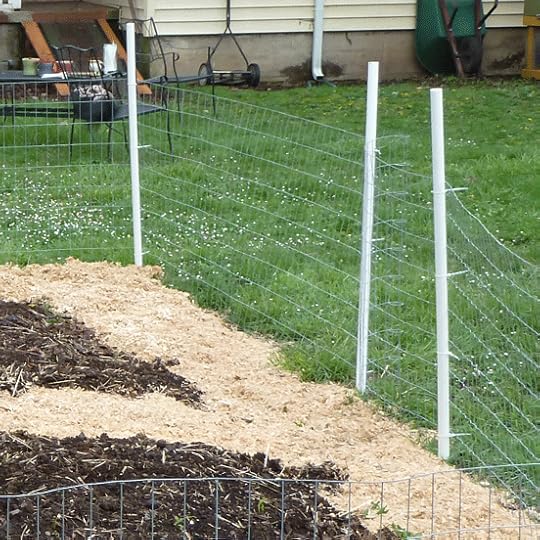 We were at the feed store this weekend and decided to spring $30 bucks for some livestock fencing. It's not the super strong goat/horse/cow fencing, but it's stronger than chicken wire.
We were at the feed store this weekend and decided to spring $30 bucks for some livestock fencing. It's not the super strong goat/horse/cow fencing, but it's stronger than chicken wire.
I used rebar hammered into the ground so about two feet remained above ground level. Our local recycling store, Bring, is basically giving away PVC pipes. I put those over the rebar as fence posts. With my little nephews helping out, we wound the fencing around the beds and used plastic zipties to hold them to the existing fence and the PVC pipes.
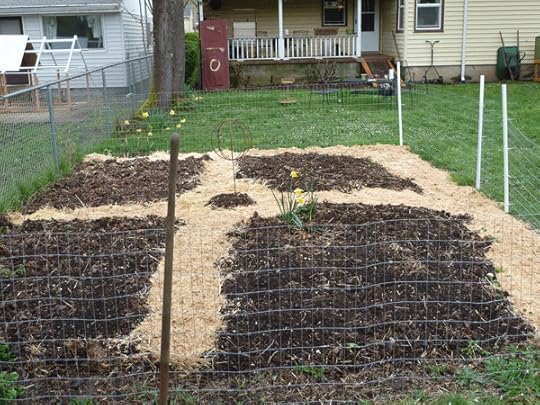 I am surprised about a few things. It was super easy. It was fairly cheap. And it's totally portable. When we move out of this rental house, we just have to pull up the PVC pipes and rebar, wind up the fencing, and move into the next place.
I am surprised about a few things. It was super easy. It was fairly cheap. And it's totally portable. When we move out of this rental house, we just have to pull up the PVC pipes and rebar, wind up the fencing, and move into the next place.
It's not perfect, mind you. A couple more PVC/rebar fence posts halfway long the sides will help it not to sag. The entrance into the garden is "rustic". I basically left an overhang on the fencing that you roll back to enter. I hook it to the opposite fence post to keep it "closed".
No more chickens scratching up the vegetable patch. And no more cats (including ours) using the nice garden loam as a litter box. A little ingenuity and thirty bucks sure went a long way for us this weekend!
***Reminder, you can come visit me at Powell's Burnside location this weekend in Portland! I will be there signing my new book, Modern Homestead, from 4:00p-6:00p.



